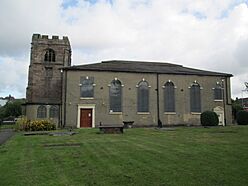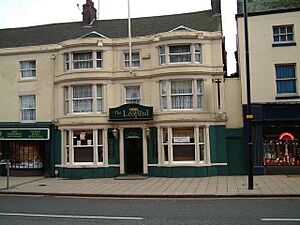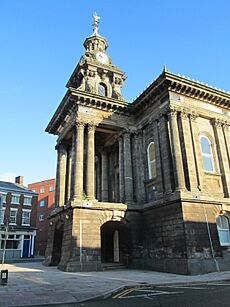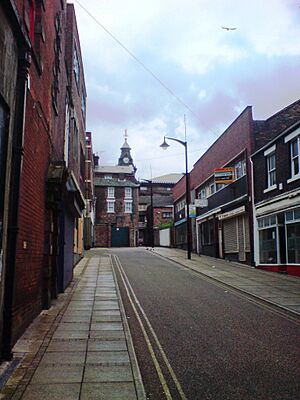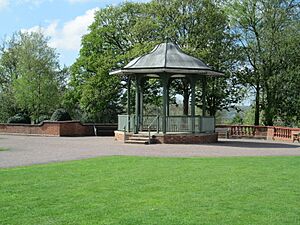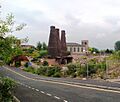Burslem facts for kids
Quick facts for kids Burslem
|
|
|---|---|
| Federated town and district | |
|
|
| Population | 6,940 (2021 Census) |
| OS grid reference | SJ875495 |
| Unitary authority | |
| Ceremonial county | |
| Region | |
| Country | England |
| Sovereign state | United Kingdom |
| Post town | STOKE-ON-TRENT |
| Postcode district | ST6 |
| Dialling code | 01782 |
| Police | Staffordshire |
| Fire | Staffordshire |
| Ambulance | West Midlands |
| EU Parliament | West Midlands |
| UK Parliament |
|
Burslem (/ˈbɜːrzləm/ BURZ-ləm) is one of the six towns that make up the city of Stoke-on-Trent in Staffordshire, England. It's often called the "Mother Town" of Stoke-on-Trent because of its important history. In 2021, about 6,490 people lived here.
Contents
- Discovering Burslem: A Look at the Town
- A Journey Through Burslem's History
- People and Homes in Burslem
- Burslem's Economy and Businesses
- Things to See and Do in Burslem
- Sports in Burslem
- Learning in Burslem
- Burslem's Green Spaces
- Getting Around Burslem
- Famous People from Burslem
- Images for kids
- See also
Discovering Burslem: A Look at the Town
Burslem is located on a ridge overlooking the Fowlea Valley. This valley is home to the Fowlea, an early river that flows into the River Trent. The town includes areas like Middleport, Longport, and Smallthorne.
The Trent and Mersey Canal runs through the west and south parts of the town. A bit further west, you'll find the West Coast Main Line railway and the A500 road. These form a clear border between Burslem and the nearby town of Newcastle-under-Lyme. To the south, there's Grange Park and Festival Park. These areas were created from land used for the Stoke-on-Trent Garden Festival.
A Journey Through Burslem's History
Burslem was first mentioned in the Domesday Book as Bacardeslim. It was a small farming village back then. It was placed in a good spot above a river crossing at Longport. This crossing was part of a major path for pack horses coming from the Peak District.
Early Pottery and Growth
As early as the late 1100s, Burslem had a busy pottery industry. This was thanks to the excellent local clay. After the Black Death in the 1300s, Burslem grew into a medieval town. The stone church built in 1536 is still standing and used today.
For a long time, Burslem was quite isolated. It didn't have a nearby river that boats could use. The roads were also not very good. But by 1777, the Trent and Mersey Canal was almost finished. The roads had also gotten much better. The town then grew very quickly because of its fine pottery and the new canals. This is why it became known as 'The Mother Town'.
Becoming Part of Stoke-on-Trent
In 1910, Burslem joined with other towns to form the county borough of Stoke-on-Trent. This borough was officially made a city in 1925.
Many novels by Arnold Bennett describe Burslem during the Victorian era. They show its many potteries, mines, and canal barges. The artist and playwright Arthur Berry also captured Burslem life from the 1930s to the 1980s in his paintings and plays.
Burslem is special because it still has many old industrial buildings from the 1800s. People used to live close to the factories where they worked. This means much of its history and character are still visible today. Experts say the area around the canal is one of the richest in England for industrial history related to pottery.

People and Homes in Burslem
In 1991, Burslem had about 21,400 people. Even though many factories closed in the 1980s and 90s, the number of people living in Burslem has stayed steady.
Most homes in the town are traditional terraced houses. These were built during the Victorian and Edwardian times. New houses are also being built in some areas.
There are good healthcare facilities nearby. The Haywood Hospital is in Burslem. The large University Hospital of North Staffordshire is also only three miles away.
Burslem's Economy and Businesses
The pottery industry has changed a lot since the 1970s. Large-scale production has gone down. However, special pottery makers like Steelite and smaller companies making valuable ceramics are doing well. Burslem is also becoming a place for small creative businesses. These include fine art, animation, and crafts, as well as pottery.
The number of shops in the town centre has decreased. This is partly because of large shopping areas outside of town that offer free parking. But Burslem still has a lively evening scene with many bars and restaurants. They mainly serve English and Indian food.
The Burslem Market Hall is a historic building from 1879. It was used until 2003 when it was closed for safety reasons.
In 2019, Burslem's last bank closed. This meant the town no longer had any free cash machines. It was the first large town in the UK to be without one.
Local Media
You can watch local TV news from BBC Midlands Today and ITV News Central.
Local radio stations include BBC Radio Stoke, Hits Radio Staffordshire & Cheshire, and Greatest Hits Radio Staffordshire & Cheshire. There are also community stations like 6 Towns Radio and HitMix Radio.
The Leopard Inn
The Leopard public house, or Leopard Inn, is a very old building. It dates back to the late 1700s. It was updated around 1830 and made bigger in the 1870s. More than 50 bedrooms were added at the back.
In 1765, an important meeting happened here. Josiah Wedgwood, Thomas Bentley, Erasmus Darwin, and James Brindley met to plan the Trent and Mersey Canal. The Leopard also appears in some of Arnold Bennett's novels. It used to be a place where coaches stopped. Later, it became a big hotel. But fewer people needed rooms, so the back part closed in 1956.
In 2007, this closed-off section was rediscovered. This led to stories of ghosts and even ghost tours! The pub was bought by Bass Breweries in 1965. They renovated the restaurant and named it the Arnold Bennett Suite. The building became a protected historic site in 1972. In recent years, it was a live music venue. It was renovated but did not reopen after the COVID lockdown. In 2021, it was sold to a company that wanted to turn the back into apartments. The city council then declared it an "Asset of Community Value" to help protect it.
Things to See and Do in Burslem
About 5 million tourists visit Stoke-on-Trent each year. Many of them come back again and again. Burslem has several interesting places to visit. These include pottery makers like Burleigh and Moorcroft, Festival Park, its many pubs, and the Trent & Mersey Canal. The Old Town Hall is one of the biggest buildings in Burslem.
The town is also famous because of the novelist Arnold Bennett. He wrote about Burslem and its streets in his books, using slightly different names. For example, Burslem was called "Bursley." His famous "Clayhanger" trilogy is set here. Burslem's town centre still has many old buildings and its original street plan from the Middle Ages. It wasn't changed much in the 1960s and 70s.
The Burslem School of Art has been renovated and now has several free art galleries. The public library is currently located there. The Queen's Theatre hosts concerts and an annual pantomime.
You can also visit a traditional street market on Fridays. There are also street carnivals in May and December.
Sports in Burslem
The main football club, Port Vale, is based in Burslem at Vale Park. They play in League Two, which is England's fourth football division.
Near the town is Burslem Golf Club, a 9-hole course. The famous singer Robbie Williams was once a Junior Captain there. The course was opened in 1907 by entertainer Sir Harry Lauder.
Professional darts player Phil Taylor, who has won the world championship 16 times, is from Burslem.
Learning in Burslem
Burslem is home to one of the two campuses of Stoke-on-Trent College. This college is the largest Further Education college in Stoke and North Staffordshire. The campus focuses on media production and drama. Stoke Studio College, a school for 13- to 19-year-olds, also opened here in 2013.
Within six miles of Burslem, there are three universities: Staffordshire University in Shelton, Keele University, and Manchester Metropolitan University's campus in Alsager.
Burslem's Green Spaces
Burslem is on high ground, so it doesn't usually flood.
Parks to Enjoy
Burslem Park
The town's public park was designed by landscape architect Thomas Hayton Mawson. It opened in 1894. It's a protected historic park. It was built on old, unused land next to the Potteries Loop Line. Mawson also designed Hanley Park around the same time, also on reclaimed land. Both parks have water features.
Other Green Areas
Other green spaces near Burslem include Westport Lake, created in the 1970s. There's also the area from the 1986 National Garden Festival. This festival cleverly reused part of the old Shelton Bar steelworks site.
The Peak District National Park is only ten miles northeast of Burslem.
Burslem Cemetery
The cemetery, east of Sneyd Hill Park, was created in 1879. It was designed to be both a burial ground and a park. It covers over 11 acres and used to have walks, lodges, and a chapel. The chapel was taken down in 2008 because it wasn't used much and was expensive to maintain. The ashes of novelist Arnold Bennett are buried in his family tomb here.
Getting Around Burslem
The nearby A500 road connects Burslem to the M6 motorway. Longport railway station offers train connections south to Stoke, east to Derby and Nottingham, and north to Crewe and Manchester. Two major off-road cycle paths, part of the National Cycle Network, also run through the town.
The Trent and Mersey Canal is very busy, with over 10,000 narrowboats using it each year. The old Burslem Canal was built in 1805. It stayed open until 1961. This canal was a branch of the Trent and Mersey Canal.
The closest international airports are Manchester and Birmingham. Both are about 60 minutes away by train.
Burslem railway station opened in 1873. It was on the Potteries Loop Line. It closed in the 1960s, and the old railway line is now a green pathway.
Famous People from Burslem
Burslem has been home to many notable people. These include the famous potter Josiah Wedgwood. The watercolour painter James Holland (1800–1870) was also from here.
Lemmy, the founder and lead singer of the band Motörhead, grew up here. Singer Robbie Williams was a major shareholder in Port Vale, and his family still lives in the area. Darts legend Phil Taylor, a 16-time world champion, was born, raised, and worked in Burslem.
In the 1600s, Molly Leigh lived in the town. She was accused of being a witch before she died in 1748. Painter James Astbury Hammersley also came from Burslem.
William Clowes, one of the founders of Primitive Methodism, was born in Burslem. So was the potter John Bennett. Sarah Benett (1850–1924), a Suffragette and social reformer, lived in Burslem from 1894.
William Boulton's Providence Works and Foundry was based in Burslem. He designed and built machines that changed the pottery industry in the late 1800s.
Images for kids
-
Disused Bottle ovens of Acme Marls on Bourne's Bank, Burslem, Stoke-on-Trent, with St. John's Church, Woodbank Street, in the background whose sandstone tower dates from 1536 (Photographed May 2008)
See also
 In Spanish: Burslem para niños
In Spanish: Burslem para niños


